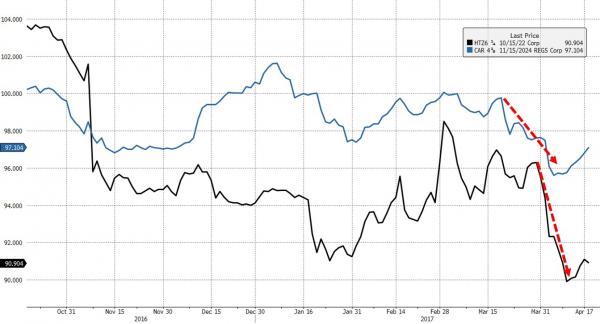
Once hedge fund darlings, almost no one is more perfectly aligned to get obliterated by falling used car prices than America’s auto rental companies, Hertz and Avis. As Bloomberg notes today, on a combined basis, Hertz and Avis dump about 400,000 vehicles per year into the used car market and operate fleets that are multiple times larger.
And with used car prices plunging, bondholders are starting to get slightly anxious about the collateral impact of writing down billions of dollars worth of capital assets.
Debt issued by Hertz Global Holdings Inc. and Avis Budget Group Inc., which had traded at or above par in recent years, tumbled to new lows earlier this month amid signs that used-vehicle prices are dropping twice as much as expected. That’s bad news for companies that collectively have to dispose of about 400,000 vehicles a year, and especially for Hertz, whose junk-rated debt is teetering close to a downgrade.
Hertz and Avis typically buy the cars outright from manufacturers or get them on a contract with a buyback agreement. The latter, called program cars, cost more because manufacturers assume the resale price risk. Vehicles that Avis and Hertz buy outright are called risk cars because rental companies make their own assumptions about what the cars will be worth when it’s time to sell. Combined with closely held Enterprise Holdings Inc., the three companies control more than 95 percent of the U.S. rental fleet, according to Manheim.
Program cars made up only 20 percent of Hertz’s U.S. fleet last year, according to a company filing, less than half the 44 percent for Avis’s total fleet. Hertz will try to buy more of those this year, Chief Financial Officer Tom Kennedy told investors during a February earnings call.

Of course, as J.D. Power pointed out in it’s most recent “NADA Used Car Guide Industry Update,” the flood of lease returns has just started to push used car prices lower….















